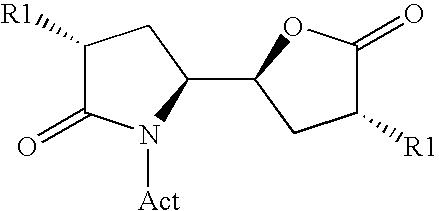Methods
a technology of lactam lactone and compound, applied in the field of new methods to prepare c8 lactam lactone compounds, can solve the problems of demanding synthesis of enantiomerically pure compounds, and achieve the effect of simplifying the method of preparation
- Summary
- Abstract
- Description
- Claims
- Application Information
AI Technical Summary
Benefits of technology
Problems solved by technology
Method used
Image
Examples
example 1a
Organocatalytic Michael Addition of “In Situ” Generated Nitroethylen to Isovaleraldehyde and Reduction of the Resulting Aldehyde by NaBH4 and Organocatalyst A1: (S)-Diphenyl-prolinol-O-TMS-ether
[0211]
[0212]2-Nitroethyl benzoate (7.8 g, 40 mmol) and (5.3 g, 61.5 mmol) isovaleraldehyde are dissolved in a mixture of 50 ml of toluene and 5 ml of acetonitrile at room temperature. (S)-diphenylprolinol-O-TMS-ether (1.3 g, 4 mmol) is added at room temperature. To this solution is then added under stirring at 0° C. within 5 minutes (5.05 g, 50 mmol) of N-methyl morpholine to give a slightly yellow turbid solution. After 24 hours at ca. 0° C. all 2-nitroethyl benzoate is consumed (HPLC control). For work up and reduction the formed 4-nitro 2-isopropyl butyraldehyde (solution in toluene) is added slowly within 20 minutes to a well stirred solution of 4.0 g (160 mmol) of sodium borohydride in a mixture of 30 ml of water and 30 ml of ethanol. Vigorous hydrogen evolution is observed at the beginn...
example 1b
Organocatalytic Michael Addition of “In Situ” Generated Nitroethylen to Isovaleraldehyde and Reduction of the Resulting Aldehyde by NaBH4 with Organocatalyst A2, (S)-Diphenyl-prolinol-O-TBDMS-ether and Different Work Up
[0221]2-Nitroethyl benzoate (11.71 g, 60 mmol) and (9.3 g, 108 mmol, 1.8 equ.val) isovaler-aldehyde are dissolved in a mixture of 75 ml of toluene and 7.5 ml of acetonitrile at room temperature. (S)-diphenylprolinol-O-TBDMS-ether (1.76 g, 4.8 mmol, 8 mol %) is added at room temperature. The reaction mixture is cooled to 0° C. and 6.98 g (69 mmol) of N-methyl-morpholine is added via dropping funnel in 30 minutes. The reaction mixture is stirred over night at 0° C. and conversion is controlled by HPLC to show 90% conversion. Additional N-methylmorpholine is added and stirring is continued at room temperature for 5 hours. To the reaction mixture is added 30 ml of water for extraction of salts, then further extracted with aqu. Citric acid solution (30 ml) and finally with...
example 2
Organocatalytic Michael Addition of “In Situ” Generated Nitroethylen to Propionaldehyde and Reduction of the Resulting Aldehyde by NaBH4
[0222]
[0223]The organocatalytic reaction was performed as in Example 1:
[0224]2-Nitroethyl benzoate (4.68 g, 24 mmol) and (3.5 g, 60 mmol) propionaldehyde are dissolved in 30 ml of hexane. (S)-diphenylprolinol-O-TMS-ether (1.95 g, 6 mmol) is added at room temperature. To this solution is then added under stirring at 0° C. within 3 hours (3.45 g, 30 mmol) of N-ethyl morpholine as hexane solution to give a slightly yellow turbid solution. After 3 hours stirring at ca. 0° C. all 2-nitroethyl benzoate is consumed (HPLC control). To the reaction mixture is then added 15 ml of ethanol followed by portionwise addition of 1 g (40 mmol) of sodium borohydride. The reaction mixture becomes very thick and therefore 20 ml of water is added to get a clear solution. Hydrogen evolution is observed at the beginning. After 30 minutes the reduction is complete. The re...
PUM
 Login to View More
Login to View More Abstract
Description
Claims
Application Information
 Login to View More
Login to View More - R&D
- Intellectual Property
- Life Sciences
- Materials
- Tech Scout
- Unparalleled Data Quality
- Higher Quality Content
- 60% Fewer Hallucinations
Browse by: Latest US Patents, China's latest patents, Technical Efficacy Thesaurus, Application Domain, Technology Topic, Popular Technical Reports.
© 2025 PatSnap. All rights reserved.Legal|Privacy policy|Modern Slavery Act Transparency Statement|Sitemap|About US| Contact US: help@patsnap.com



